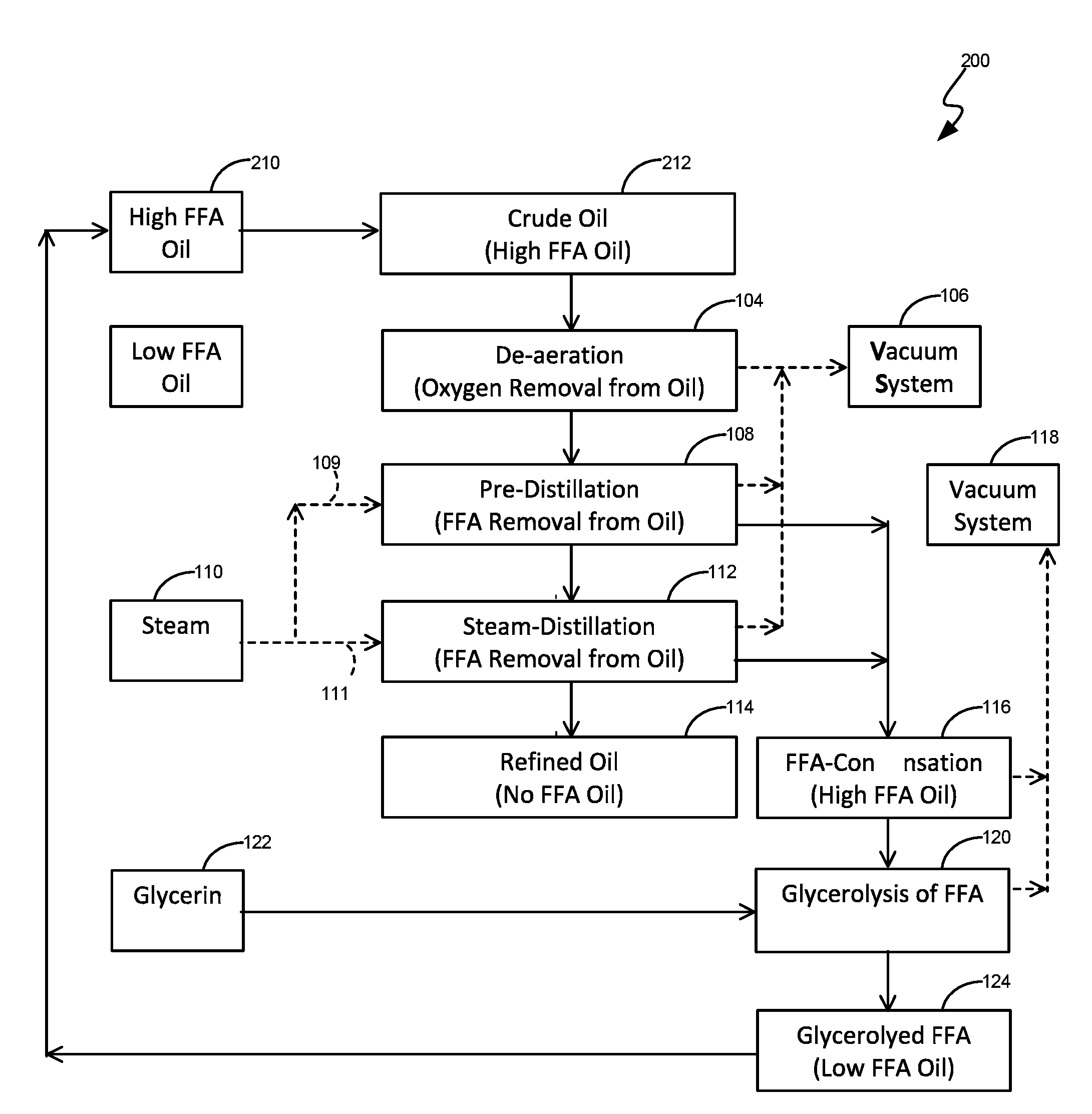Process for converting low and high free fatty acid containing oils into no free fatty acid containing oils and associated systems and devices
a technology of free fatty acid and process, which is applied in the field of oil, can solve the problems of increasing the cost of biodiesel production, unable to compete with petro-diesel, and the price of nfa oil, so as to reduce waste and energy consumption and increase yield
- Summary
- Abstract
- Description
- Claims
- Application Information
AI Technical Summary
Benefits of technology
Problems solved by technology
Method used
Image
Examples
example 1
LFFA Oil (i.e., Oil Containing Up to about 1-20% FFA)
[0037]Step-1: As shown in FIGS. 1-2 generally at 10 and 100, the low free fatty acid (“LFFA”) process according to certain implementations includes a FFA stripping step wherein LFFA oil (1-20% FFA by wt %) is first stripped of FFA. With reference to FIGS. 1A-D, the LFFA oil (shown in FIG. 2 at box 102) is pumped out of the low fatty acid tank 12 by a pump 14 through a start-up heater 16 to a deareator 18. In this implementation, the deareator 18 is configured to remove any air or moisture contained in the feedstock (shown in FIG. 2 at box 104). In various implementations, the deaerator 18 operates at temperature of 70° C.-120° C. (preferably between 80-100° C.) and a pressure of 25-200 mm Hg absolute depending upon the moisture content (preferred between 50-75 mm). The deaerator 18 is in sealed fluidic and hermetic communication with the vacuum system 80 to regulate the pressure inside the deaerator 18 (shown in FIG. 2 at box 106)...
example 2
Oil Containing More than about 20% FFA
[0043]Step-1: As shown in FIGS. 1-1D and 3 at 10 and 200, in certain implementations, the disclosed high free fatty acid (“HFFA”) process consists of a glycerin-esterification step wherein the HFFA containing oil (20-100% FFA, shown in FIG. 3 at box 210) is pumped from a high fatty acid tank 54 with a pump 56. The HFFA oil (box 212) is pumped through a start-up heater 60 to a reactor 62. The reaction temperature is between 160° C. to 300° C. (preferably between 200-260° C.) at a pressure of 10 mm to 150 mm Hg absolute (preferably between 30-75 mm Hg absolute).
[0044]Correspondingly, glycerin (box 122) is pumped from a glycerin tank 66 into the reactor 62 with a dozing pump 64. The fatty-acid contained in HFFA oil reacts with glycerol and converts to oil (box 120). A byproduct of the reaction is water. The water is continuously removed from the reactor due to heat and vacuum. Any glycerol that is vaporized and carried along with water is condensed...
PUM
 Login to View More
Login to View More Abstract
Description
Claims
Application Information
 Login to View More
Login to View More - R&D
- Intellectual Property
- Life Sciences
- Materials
- Tech Scout
- Unparalleled Data Quality
- Higher Quality Content
- 60% Fewer Hallucinations
Browse by: Latest US Patents, China's latest patents, Technical Efficacy Thesaurus, Application Domain, Technology Topic, Popular Technical Reports.
© 2025 PatSnap. All rights reserved.Legal|Privacy policy|Modern Slavery Act Transparency Statement|Sitemap|About US| Contact US: help@patsnap.com



